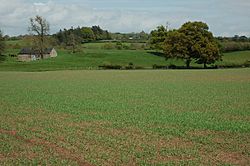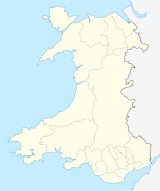Castell Arnallt facts for kids
Quick facts for kids Castell Arnallt |
|
|---|---|
| Monmouthshire, Wales | |

Site of Castell Arnallt
|
|
| Coordinates | 51°47′06″N 2°59′13″W / 51.785°N 2.987°W |
| Type | Castle |
| Site information | |
| Condition | Earthworks - no other visible remains |
The place where Castell Arnallt once stood is near Llanover village. This is in the Usk valley of Monmouthshire, Wales. It's about 4 miles (6.4 km) southeast of Abergavenny.
Castell Arnallt was a strong home or llys for Seisyll ap Dyfnwal. He was a powerful leader of a region called Over Gwent. The castle was destroyed in 1175 after Seisyll and some of his family were killed. This happened at Abergavenny Castle by William de Braose. Today, the land is used for farming, and you can't see any remains of the castle.
Contents
History of Castell Arnallt
How it Started
Castell Arnallt was a medieval fort. People believe it was the strong home of the Welsh rulers of Over Gwent. This area was also known as Gwent Uwch Coed. The castle was part of the lands owned by Dyfnwal ap Caradog. He might have lived at Penpergwm, which is near Abergavenny.
Its Use and Destruction
In the 12th century, King Henry II of England recognized Dyfnwal's son, Seisyll ap Dyfnwal. Seisyll became the lord of Over Gwent. He also gained control of Abergavenny Castle. This happened after he helped release a hostage, Hugh de Beauchamp.
Later, to make peace between The Lord Rhys and King Henry II, Seisyll gave control of Abergavenny Castle to William de Braose. Seisyll was The Lord Rhys's brother-in-law. In 1175, Abergavenny Castle was attacked. A man named Henry Fitzmiles was killed. People said Seisyll was responsible. Fitzmiles' lands, including Abergavenny Castle, then went to William de Braose. He was married to Henry Fitzmiles' sister, Bertha.
De Braose invited Seisyll to his castle for Christmas in 1175. He said he wanted to make peace. Other leaders from Gwent and Seisyll's son Geoffrey were also invited. But instead of peace, De Braose had Seisyll and the other men killed. This happened during a feast in the castle's great hall. This event is known as the Massacre of Abergavenny. De Braose then took Seisyll's land.
While Seisyll was at Abergavenny Castle, William de Braose's men attacked Castell Arnallt. They surprised the castle, destroyed it, and killed Seisyll's other son, Cadwaladr. Seisyll's wife was either taken or killed during this attack. The castle was completely destroyed by 1177.
What Happened Later
In 1325, Castell Arnallt's lands were given to Sir William de Hastings. He was a relative of the lord of Abergavenny. After the castle was destroyed, the land was only used for farming. Experts have studied the site, but they haven't dug it up. Since 1947, it has been protected as an Ancient Monument.
What's Left Today
All that remains of Castell Arnallt is a large, oblong mound. It sits in a field used for grazing animals. This field is on the edge of the flood plain of the River Usk. There are two enclosed areas. One is on top of the mound, and the other is on its western side.
When the mound was examined, it looked like there might be hidden structures. These could include a gate and stone walls beneath the surface. These structures were likely built over time. It's believed that Castell Arnallt was a llys, or royal court. It was used for managing the area before 1175. Experts think it was built without a motte (a large earth mound for a tower). Instead, it used the natural shape of the land for defense.


